Scary but Normal Baby Problems and How to Solve Them
For all the joy of having a new baby in the home, there are times when things seem amiss. This is especially true for first-time parents who might notice quirks about baby that seem terrifying to adults but are perfectly normal for a developing human.
Sometimes, it’s easy to be guided by instinct, such as with a crying baby. Most of the time they’re either hungry, tired or uncomfortable. There’s not much guesswork there, and the solutions are straightforward enough. But what about patches of skin that don’t look as plush and soft as the rest of baby’s body, or huge amounts of saliva dripping out of baby’s mouth all day, or sudden hair loss or flaky skin that makes baby look like a reptile? Are those things normal, or should parents be calling their pediatrician at all hours and making near daily trips to the ER?
The short answer is many seemingly frightening things that baby experiences are actually normal and healthy. But sometimes they’re not. It’s easy to get spooked, so let’s give you some peace of mind by taking a look at common baby problems and their solutions.
The Problem: Hiccups

LightFieldStudios / Getty Images
What it is: Diaphragm contractions and rapid closing of vocal cords.
Cause: Unknown. May be the result of eating too fast, becoming suddenly cold or moving around a lot right after feeding.
Prevention: Feed your baby before they start crying in desperation, hold them upright after eating for 20 to 30 minutes, and avoid bouncing up and down or doing other heavy activities immediately after a feeding.
The Solution
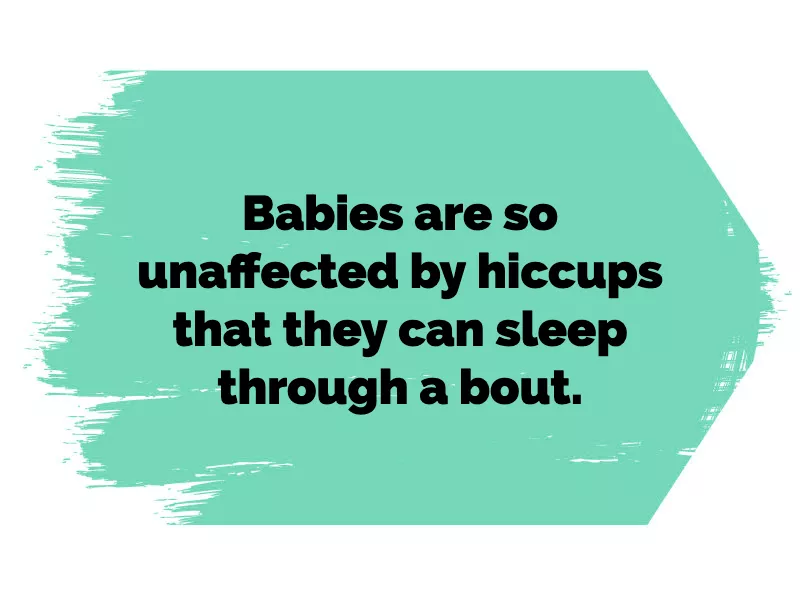
Treatment: It’s best to just let them run their course. The first few times they happen, it’s alarming for parents, but babies are so unaffected by hiccups that they can sleep through a bout. If you must stop them, try burping your baby, giving them a pacifier or feeding them gripe water, an herbal water solution that is supposed to help with intestinal discomfort.
When to contact the doctor: If hiccups still happen often after 12 months or if baby is extremely bothered by hiccups and they occur frequently.
The Problem: Cradle Cap

andriano_cz / Getty Images
What it is: Scaly patches of crusty or oily skin on the scalp.
Cause: Unknown. May be the result of leftover hormones passed from mother to child before birth, which can cause excessive sebum oil production, or a yeast fungus that grows in sebum. Cradle cap is not contagious and isn’t caused by poor hygiene.
Prevention: Use a mild shampoo every few days.
The Solution

Treatment: Try daily washing with a mild shampoo or, only with a doctor’s consent, an anti-dandruff shampoo. Applying mineral oil 30 minutes before shampooing also helps loosen the scales, as does a soft-bristled toothbrush while washing. Or, since it’s not painful or itchy for baby, just let it pass, which can take anywhere from a few weeks to a few months.
When to contact the doctor: If you’ve tried these treatments with no success or the scales spread to baby’s face or other parts of the body.
The Problem: Acne
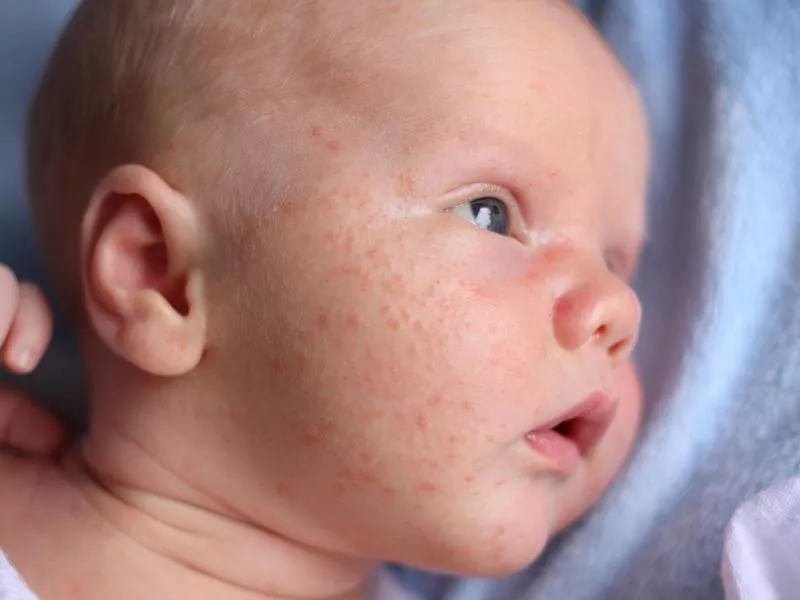
princessdlaf / Getty Images
What it is: Red or white bumps all over baby’s face and sometimes neck and body, appearing a few weeks after birth.
Cause: Unknown. May be hereditary.
Prevention: Make sure baby’s face is clean and avoid using lotion or oil on their face. Don’t pinch or scrub the acne, just leave it be.
The Solution
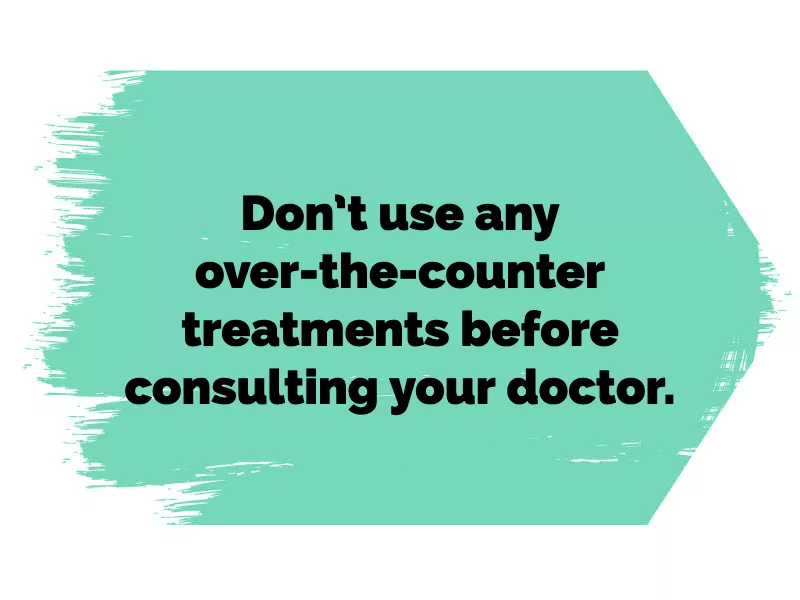
Treatment: Usually, you can just let it pass, which can take up to four months. If it persists, the doctor might prescribe a medicated cream. Don’t use any over-the-counter treatments before consulting your doctor, as these products might damage baby’s delicate skin.
When to contact the doctor: If you or someone in your family has a history of severe acne, it would be wise to tell this to your pediatrician. Also, let them know if baby has been exposed to any medications that might cause acne, like corticosteroids or drugs that contain iodine.
The Problem: Hair Loss

yaoinlove / Getty Images
What it is: Baby lost a lot of hair in the first six months, or there’s a bald spot on the back of their head.
Cause: For hair loss, it’s a normal occurrence caused by a drop in hormone levels after birth (the same thing actually happens to moms, and their hair loss can be more pronounced). Cradle cap might also result in some hair loss. Bald spots are caused by baby spending too much time in the same position, such as during sleep.
Prevention: Nothing for general hair loss. It may or may not happen, but the hair will grow back and often will be a completely different color. For bald spots, rotating sleep positions and tummy time will help as well as making sure to change baby’s position often.
The Solution

Treatment: Just let it run its course.
When to contact the doctor: In rare cases, a doctor visit might be needed. Those include fungal infection called ringworm that causes patchy bald spots with flaky red skin; traction alopecia in which tightly pulled hair, such as for a ponytail, causes hair loss; patchy bald spots called trichotillomania caused by compulsive hair-pulling; or alopecia areata in which the immune system targets hair follicles and dramatically reduces hair growth. Thyroid disorder or an underactive pituitary gland also might cause hair loss.
The Problem: Lanugo
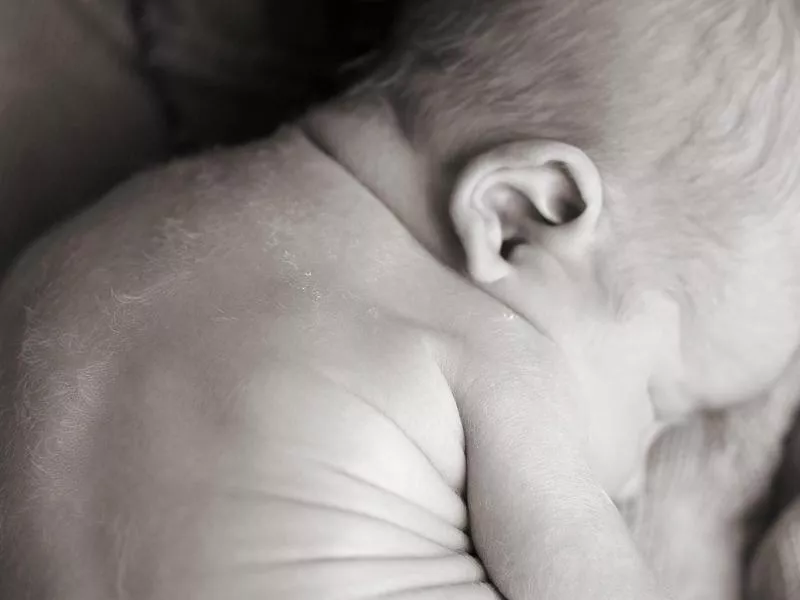
ideabug / Getty Images
What it is: Fine hairs on the back, arms, legs, forehead and upper lip.
Cause: It’s leftover from baby’s time in the womb, when they needed hair to help regulate body temperature until they developed sufficient fat. Most babies lose this hair at the end of the pregnancy, but it’s common for it to linger for weeks to months after birth. This is especially the case for preemies and babies with dark complexions.
Prevention: Nothing.
The Solution
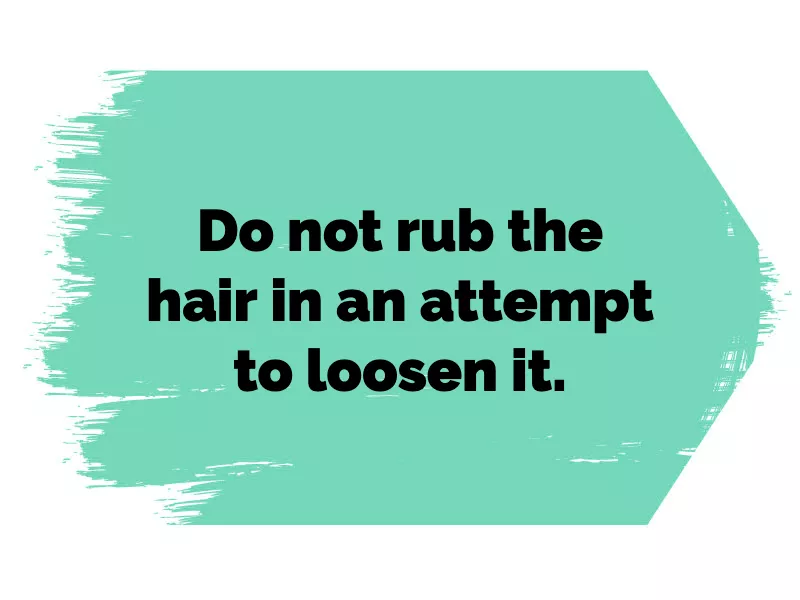
Treatment: None. Do not rub the hair in an attempt to loosen it, as this will irritate baby’s sensitive skin. The hair will eventually go away.
When to contact the doctor: In rare cases, the excessive hair growth might be caused by congenital adrenal hyperplasia in which baby is producing too many male hormones because of a deficiency in cortisol or aldosterone.
The Problem: Grunting

Yasin Emir Akbas / Getty Images
What it is: Male and female babies can produce noises that sound like they came from an old man who’s smoked cigarettes for 50 years. It might sound painful but is usually nothing to be concerned with.
Cause: It’s likely these sounds are the result of baby learning how to pass stool. Adults use their stomach muscles to help move stuff through the gut, but babies are not strong enough to do this right away, so they use their diaphragm instead and that’s when the grunts happen.
Prevention: Nothing. Baby will stop grunting heavily after a few months when the stomach muscles are more developed.
The Solution

Treatment: If the grunting is due to constipation, rubbing petroleum jelly on the anus can help to pass stool but also might prevent them from learning how to do this on their own.
When to contact the doctor: Most of the time grunting is normal, but it can also mean something serious. Seek treatment if you see the following: Baby seems overly distressed by the grunting, regularly grunts after breathing, is exhibiting fever symptoms, has blue lips or tongue, pauses between breaths, flares nostrils or draws in their chest during breathing. Fever and vomiting might also indicate meningitis or blood poisoning called sepsis, and shortness of breath, sweating and lack of weight gain might indicate heart failure.
The Problem: Bloody Diaper

Ridofranz / Getty Images
What it is: Spots of blood appear in your newborn’s diaper.
Cause: In females, elevated hormone levels can cause a bloody discharge similar to a period. It may take a few weeks for hormone levels to return to normal. In males, circumcision can cause blood spots as the foreskin heals. For all babies, severe diaper rash can cause blood spots. Sometimes, a scratch or small tear in the rectum can lead to blood spots as well, and occasionally a small cut in mom’s nipple will result in a little blood in the stool.
Prevention: Nothing.
The Solution

Treatment: For a rectum tear, moisturizer works well. For other causes, patience should prevail.
When to contact the doctor: If the bleeding is persistent or heavy, or baby appears to be ill with a high fever or bruises easily.
The Problem: Inconsistent Stool

ozgurcankaya / Getty Images
What it is: Bowel movements come in many shapes, sizes and colors, but some are better than others. Some babies poop every day or multiple times a day, while others do it every few days. For simplicity, we’ll only discuss breast milk and formula stools since color, consistency and frequency change dramatically with the introduction of other foods.
Cause: Baby stool should be a few different shades. In the first few days, baby will be expelling meconium. This greenish-black sticky stuff resembles tar or motor oil, but it’s a good sign because it means baby is getting rid of amniotic fluid, skin cells and mucus. Healthy infants will then have orange, yellow or brown poop, regardless of whether they’re breast- or formula-fed. Breast milk stool is runny and seedy, while formula stool is thick like peanut butter.
Prevention: Nothing.
The Solution

Treatment: Varies depending on the issue.
When to contact the doctor: If stools are white, slimy green, red, runny, or hard and pebble-like, it’s time to be concerned. This can indicate diarrhea, constipation, poor digestion, fever or something more serious like low bile production or intestinal infection.
The Problem: Being Startled Easily

Chyna1988 / Getty Images
What it is: Moro reflex. If baby feels like they’re falling, hears a loud noise or moves suddenly, they might extend their legs and arms, arch their back, then curl up again. They might cry while doing this, even during sleep. These reflexes are normal, but they can be unpleasant for babies.
Cause: Baby is learning how to do things and developing reflexes, which doctors will also check for to ensure baby is reacting properly.
Prevention: While there’s nothing inherently worrisome about these reflexes, they can cause baby to wake up or not sleep well. Swaddling helps with sleep, as does keeping baby close to your body as you lay them down.
The Solution
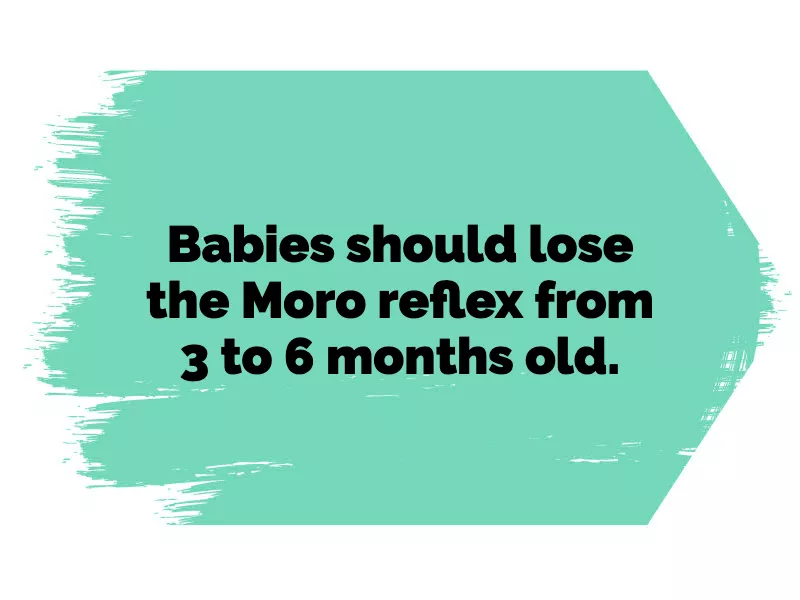
Treatment: None. Babies should lose the Moro reflex from 3 to 6 months old.
When to contact the doctor: If reflexes seem odd or don’t happen consistently or on both sides of the body, there might be an underlying issue such as a shoulder or nerve injury. Doctors check for reflexes during early routine visits, so they might even see an issue before parents do.
The Problem: Throbbing Fontanel

Demkat / Getty Images
What it is: There are actually two of these soft spots on baby’s head, on the top and in the back, and they can appear to be beating like a heart. These spots are soft to help the head pass through the birth canal and to help the skull change shape as the head grows.
Cause: Everyone’s first thought is that this is the exposed brain and touching it will cause severe damage, but thankfully that’s not the case. The brain is protected by a membrane layer, so softly touching or making contact with the soft spots will cause no harm to baby. However, do not press the spots or roughly handle them because that could produce injury.
Prevention: Nothing.
The Solution

Treatment: None. The back spot will harden around 4 months old, while the top one might take up to two years.
When to contact the doctor: An overly indented fontanel might be an indication of dehydration, and a protruding one might be a sign of an infection, head injury or fluid buildup.
The Problem: Body Movements During Sleep

FatCamera / Getty Images
What it is: While asleep, baby might sit up and bang their head on the wall, lay down and smack it against their pillow or mattress, roll it from side to side or generally move their bodies a lot. It’s a scary sight, but rarely harmful.
Cause: These movements are called RMD, or rhythmic movement disorder. Perfectly healthy boys and girls can develop this disorder, and there are no documented cases or serious injuries arising from RMD. Almost two-thirds of infants develop some sort of body movement by 9 months old, with most losing it by a year and a half.
Prevention: Nothing.
The Solution

Treatment: Most kids who develop these movements do not need any help, but medications might be prescribed by a doctor if the movements are severely disturbing or injuring baby.
When to contact the doctor: If the movements are severely disruptive to normal sleep or your child injures themself.
The Problem: Jaundice

Dean Mitchell / Getty Images
What it is: Yellowing of the skin and white parts of the eyes in newborns.
Cause: Excess yellow pigment from red blood cells, called bilirubin, builds up in baby’s blood, and their immature liver can’t get rid of it quickly. It’s a common occurrence, especially for preterm babies (those born before 38 weeks).
Prevention: Lots of food. Breast-fed babies should have eight to 12 feedings a day in the first few days of life, while formula-fed tots need 1 to 2 ounces every few hours during the first week.
The Solution

Treatment: Mild cases will disappear in a few weeks, but more severe jaundice will need specialized treatment to lower bilirubin in the blood. That might include light therapy with special lamps that change the shape and structure of bilirubin molecules, making them able to be flushed out of the body in urine or stool; transfusion of blood protein that reduces antibodies that baby might have contracted from mom if the two have different blood types; or, in severe cases, blood transfusion from a donor.
When to contact the doctor: It’s good to contact your doctor, so they can determine the severity of the jaundice and recommend home treatments or something more intense.
The Problem: Sneezing

onebluelight / Getty Images
What it is: Baby needs to expel stuff caught in the nose or has a mild irritation of the nasal passageway.
Cause: More often than not, newborn sneezing is healthy because it indicates a well-functioning nervous system. Just like with adults, sneezing occurs when nasal passages are irritated. However, babies might sneeze more often because their small nasal passages are easily clogged. And since they can’t blow their nose, they need some way of clearing the blockage.
Prevention: Never smoke around you baby for many reasons, one being that it will massively irritate their nasal passages. Otherwise, keeping them away from dusty and dirty areas will also keep their noses cleaner. But there are plenty of germs even in clean homes and bedrooms, so sneezing is bound to happen.
The Solution
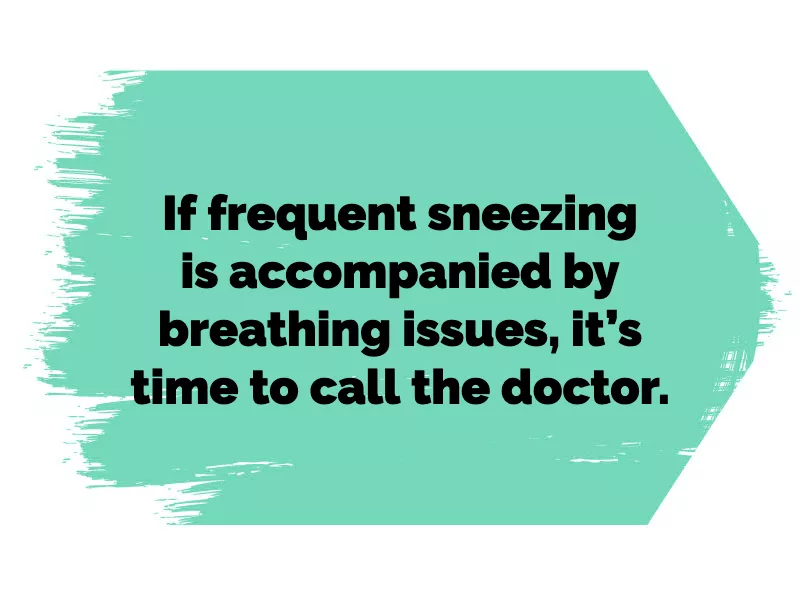
Treatment: None, unless the sneezing is excessive.
When to contact the doctor: If frequent sneezing is accompanied by breathing issues, coughing, fatigue, lack of eating and a high fever, then it’s time to call the doctor.
The Problem: Diaper Rash

Getty Images
What it is: Bright-red (inflamed) skin on baby’s bottom.
Cause: Diaper rash has a range of causes, including irritation from urine and stool, especially if baby has diarrhea; chafing from tight-fitting diapers or a new brand of diaper; ingredients in some lotions, powders or oils; a fungal infection elsewhere on the body that spread to the bottom; a new food; sensitive skin or eczema, which are less common in the diaper area; or antibiotics that baby might have taken for something else or that they ingested during breastfeeding if mom was taking something. There’s also no compelling evidence that cloth or disposable diapers have any impact on rashes.
Prevention: Keep the diaper area clean and dry, never allowing urine and especially stool to sit for very long. Naked time also helps the bottom and genitals get some fresh air and stay dry. Don’t over-tighten diapers, and a good slather of lotion after each changing never hurts.
The Solution
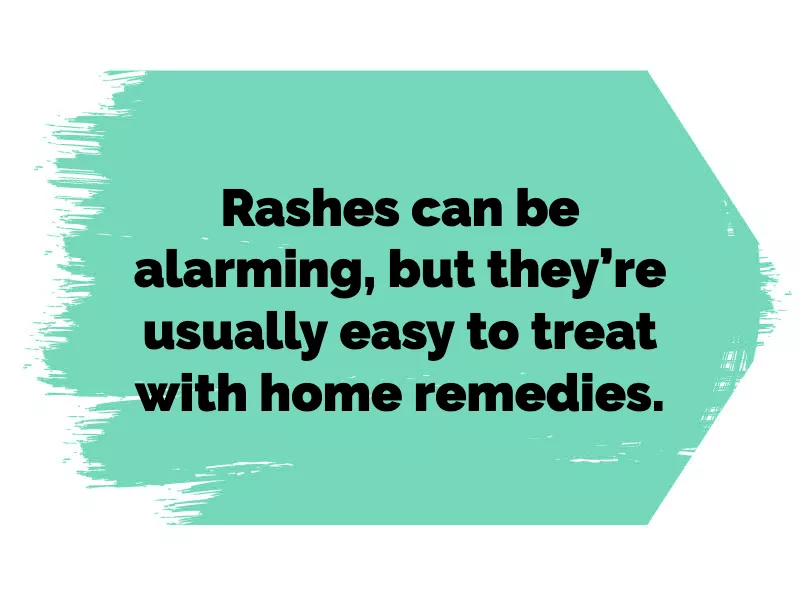
Treatment: Much the same as prevention, keep your baby’s bottom dry. Rashes should pass in a few days, and a doctor might prescribe various creams for treatment depending on the severity. Daily bathing also helps.
When to contact the doctor: Rashes can be alarming, but they’re usually easy to treat with home remedies. But if the rash persists, let the doctor know — especially if home treatments make it worse, it starts bleeding or itching, or baby develops a fever.
The Problem: Heavy Drooling

cglade / Getty Images
What it is: Baby is around 2 months old and the proverbial floodgates have opened. Saliva is everywhere and on everything, including parents’ hands and arms and everything that baby touches.
Cause: Many people think this means baby is teething, but what’s actually happening is baby’s digestive system is developing. Saliva is key for digestion and contains important enzymes that break down food and bacteria. Drooling all over toys and other things baby wants to put in their mouth will actually create a protective shield while washing away harmful bacteria. Excessive drooling will likely last for a few years or until all of baby’s teeth have come in.
Prevention: Nothing, you want this to happen.
The Solution

Treatment: None, except if baby develops a rash around the mouth or neck from too much moisture. In that case, a simple ointment barrier can be applied.
When to contact the doctor: If baby has a generalized development delay, they might have trouble swallowing all the saliva, so consulting a doctor is a good idea. And if baby develops a drool rash, ask the doctor for an appropriate ointment barrier.
The Problem: Trouble Latching on During Feeding

Getty Images
What it is: It’s a few days after birth, and baby is certainly hungry but won’t latch onto your nipple even though you’re doing everything the way you were told.
Cause: There are numerous things that could be at play, such as an odor baby doesn’t like or more unfortunate health problems like an infection or tongue tie. You might hear this being called a “nursing strike.”
Prevention: Try to avoid using a bottle too early if you’re going with breast milk over formula, as this can hinder latching. Feed baby in a quiet and calm area, and mom shouldn’t use potent perfumes, lotions or deodorants around the little one.
The Solution

Treatment: Despite baby’s need for sustenance, latching can be one of the more difficult early things to learn. Lots of skin-to-skin contact is important, as is expelling milk to not only encourage continued production but so baby can taste it.
When to contact the doctor: Sometimes, there’s a real issue at play, such as tongue-tie, in which the tongue’s range of motion is restricted due to a thick band of tissue under the tongue. Contact your doctor immediately if baby isn’t eating at all.
The Problem: Stuffy Nose, Labored Breathing
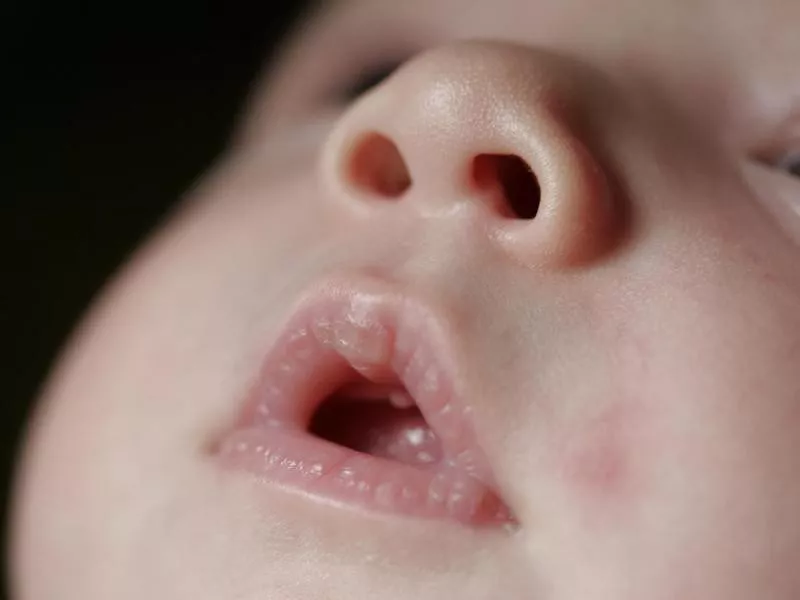
Getty Images
What it is: Baby sounds excessively stuffed up, and it seems to be negatively affecting their breathing patterns.
Cause: The small, sensitive nasal passageway is brand new and getting used to doing its job, which is to obviously provide a means to breathe but also to filter out dust and floating matter. Sometimes, spit up can get caught in there. Sometimes, it’s leftover amniotic fluid. And, sometimes, it’s a cold.
Prevention: Nothing.
The Solution

Treatment: Most doctors would advise waiting it out instead of using saline drops or an aspirator, especially if everything else is going fine and baby is eating regularly.
When to contact the doctor: If baby is not eating or the labored breathing makes it more difficult for them to eat.
The Problem: Big Breasts

Getty Images
What it is: Boys and girls alike show breasts that look much too big for their age. They show up right after birth and might continue to grow for a few days. And if you squeeze them, they might (gasp) express milk.
Cause: Exposure to maternal hormones in the womb. These hormones actually do the same thing to mom’s breasts.
Prevention: Nothing.
The Solution

Treatment: None. As the hormones work their way through the body the breasts will flatten. Resist the urge to handle them too much as that might cause irritation.
When to contact the doctor: In rare cases, the breasts might look red and especially swollen. This could happen if baby gets a fever.
The Problem: Orange-Yellow Skin

Getty Images
What it is: Not to be confused with jaundice, carotenemia is a clinical condition characterized by orange-yellow pigmentation of the skin and is most prevalent in babies and toddlers with pale skin.
Cause: Your baby or toddler is ingesting large amounts of carotene, a nutrient prevalent in foods like carrots, squash, sweet potatoes, pumpkin, spinach, beans, egg yolks, corn, yams and others. It’s even found in breast milk, and women who eat carotene-rich foods will sometimes have yellowish milk.
Prevention: Make sure baby is eating a variety of foods and mom isn’t eating too carotene heavy either.
The Solution
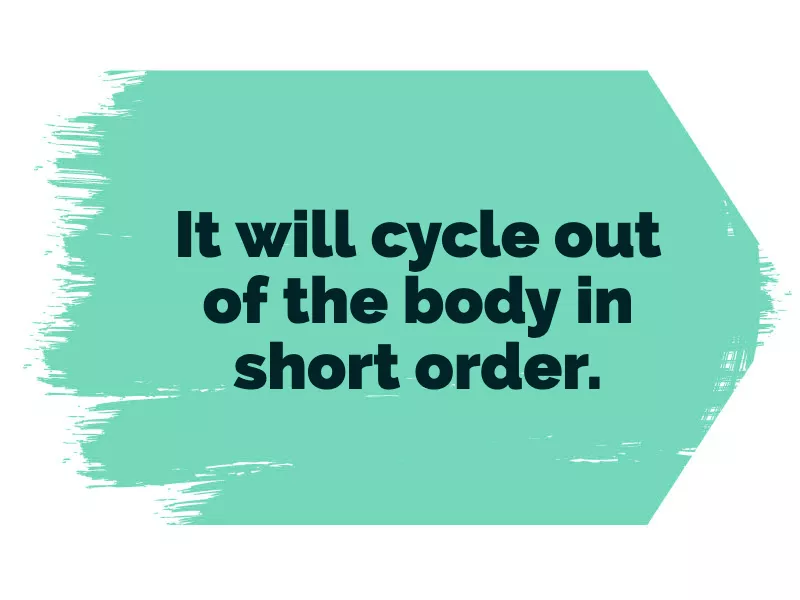
Treatment: None, it will cycle out of the body in short order.
When to contact the doctor: In rare cases, it might be a disease that causes orange-yellow skin. If your child is showing signs of illness and the skin color change, call your pediatrician.
The Problem: Tiny Breast Lumps

Getty Images
What it is: Little lumps appear around the nipples in both boys and girls.
Cause: As with enlarged breasts, this is due to maternal hormones in the womb.
Prevention: Nothing.
The Solution

Treatment: None. They should disappear in a few months as the hormones cycle out of baby’s body.
When to contact the doctor: Sometimes, the breasts will harden or redden or become quite warm, which might indicate some kind of infection.
The Problem: Infant Apnea

Getty Images
What it is: While sleeping, baby has 15- to 20-second intervals in which they stop breathing. It can be terrifying and should be addressed immediately to prevent long-term issues.
Cause: There are two types of sleep apnea: obstructive and central (OSA and CSA). The former means something is obstructing or narrowing the passageway from nose to lungs, while the latter means the brain is not telling you to breathe while you sleep. It’s unknown why central sleep apnea happens in infants, but luckily, it affects only 1 to 5 percent of babies. OSA is caused by collapsed soft tissue in the back of the throat that blocks the upper airway.
Prevention: Nothing.
The Solution
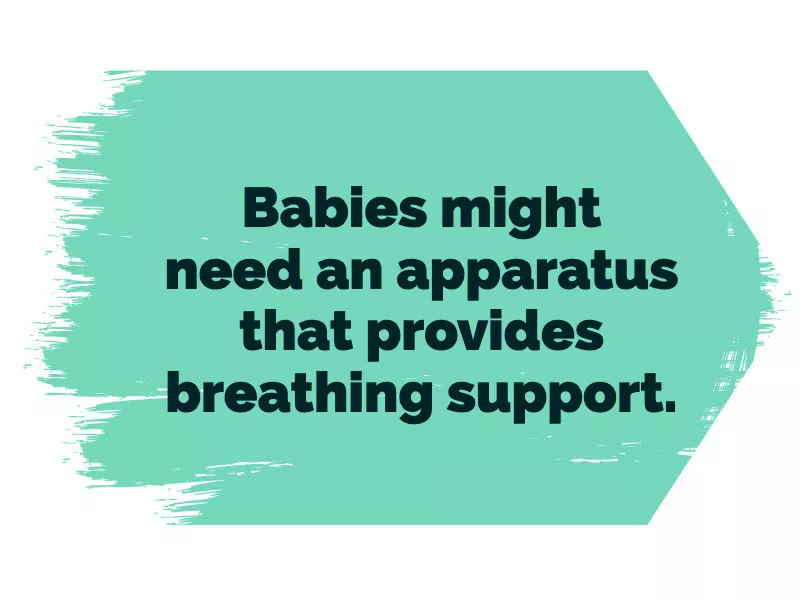
Treatment: Infants with OSA will likely outgrow the blockage as they get bigger and their upper airway expands. But some might need surgery depending on the severity. For CSA, babies might need an apparatus that provides breathing support or medication.
When to contact the doctor: Sleep apnea can be alarming and potentially life-threatening in extreme cases. It’s important to address it immediately.
The Problem: Constipation

Getty Images
What it is: Baby’s bowel movements are irregular, or they sometimes go days without pooping.
Cause: There are many. Constipation is normal when baby starts eating solid foods and when baby is young and their stomach muscles are developing (baby initially uses their diaphragm to push out stool). Formula-fed babies might have different patterns than breast-fed babies.
Prevention: It’s sometimes difficult to tell if baby is just learning how to make bowel movements or there is something preventing them from happening. It’s less about prevention and more about management or simply letting baby’s body develop.
The Solution

Treatment: If baby is older than 4 months, a few ounces of water or 100 percent pure apple, prune or pear juice can help loosen stool. If they’re eating solids and getting constipated, try switching to something that’s high in fiber like peas or barley or other grains instead of rice. Switching formulas sometimes works as well. But if you’re breastfeeding, don’t stop because of constipation until you consult your doctor. Baby doesn’t need to poop daily to be happy and healthy.
When to contact the doctor: In rare cases, constipation can be connected to a serious issue like nerve problems in the lower intestine. Call the pediatrician if baby seems severely uncomfortable or is in pain.
The Problem: Blood Trapped Between the Skull and Skin Lining

Getty Images
What it is: Blood cells accumulate between the scalp and skull and cause swelling. This is called cephalohematoma, and it can look scary.
Cause: Getting baby through the birth canal and pelvis is not easy (as you’ve probably figured out by now) and causes serious stress on their little heads and bodies. Even the most perfect labor will involve some stress and compression that can lead to bruising, swelling and cephalohematoma. More often it’s seen with difficult births.
Prevention: Nothing.
The Solution
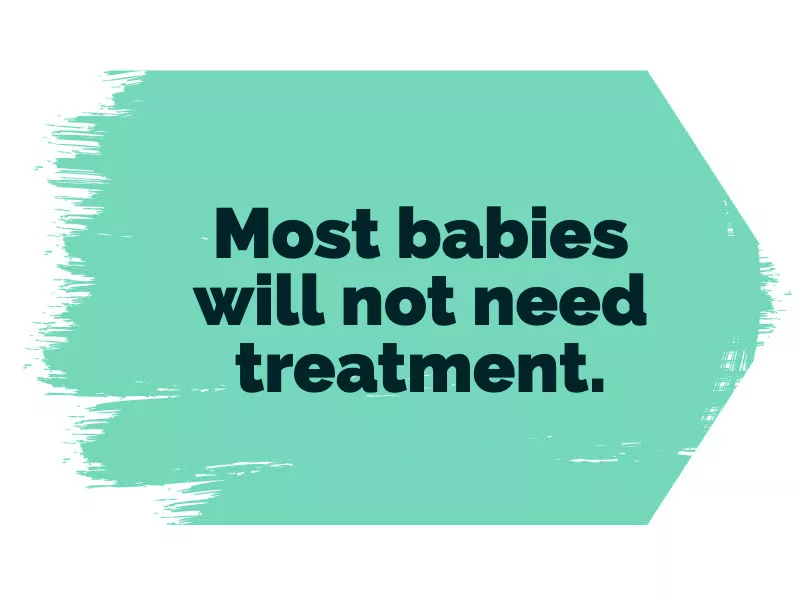
Treatment: Things might seem to get worse before they get better, with the accumulated blood hardening slightly before disappearing. Most babies will not need treatment, and the bruising will heal on its own. Sometimes, the blood might need to be drained.
When to contact the doctor: It’s good to consult your doctor to understand the severity of cephalohematoma.
The Problem: Blue Skin Color Right at Birth

Getty Images
What it is: Instead of the usual purple-red skin tone, your newborn is blue.
Cause: Lack of oxygen. Baby has been relying on mom’s placenta for oxygen up until now, so when the cord is cut, they have to breathe on their own. It takes some getting used to, so the hands and feet might even remain blue for days after birth when baby’s circulation system revs up.
Prevention: Nothing.
The Solution
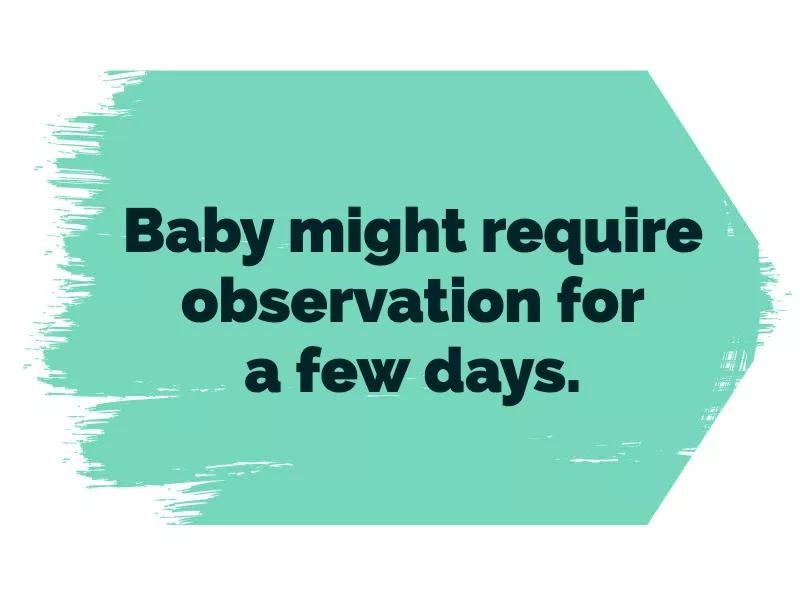
Treatment: Baby might require observation for a few days and more check-ups than normal after that. It’s typically a harmless issue but should be addressed immediately.
When to contact the doctor: If the blue coloring appears on other parts of the body.
The Problem: Frequent Spit-Ups

Getty Images
What it is: Baby spits up after most, if not all, feedings. It’s not pleasant, and for parents, it can be alarming. But there’s a big difference between spit-up and vomit.
Cause: A young and developing digestive system or overfeeding.
Prevention: Holding baby upright while feeding and afterward, burping baby often (after 1 to 2 ounces of milk), changing the nipple size on bottle-fed babies, avoiding excessive movements after feeding and generally giving baby smaller meals more often.
The Solution
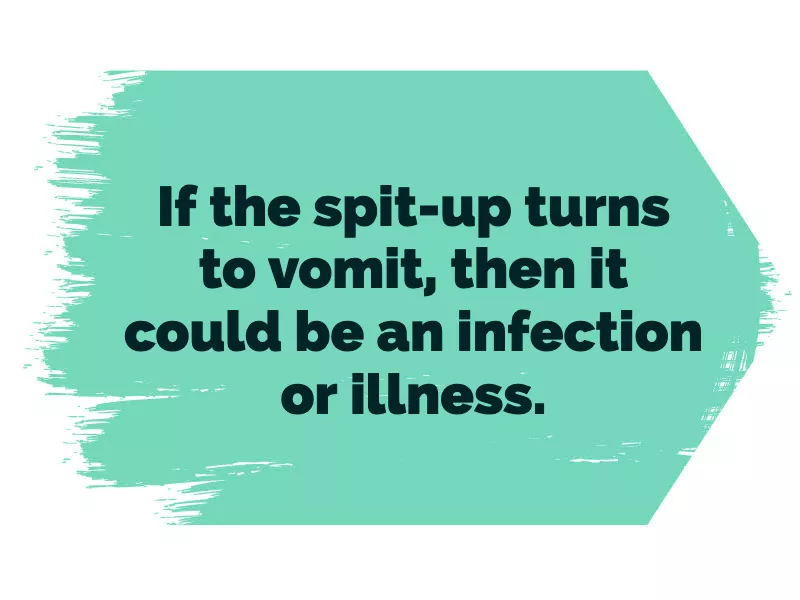
Treatment: If baby is otherwise healthy and gaining weight, no treatment is required. If it’s worse than spit-up, it might require medication.
When to contact the doctor: If the spit-up turns to vomit — i.e., it’s more forceful and in larger quantity — then it could be an infection or illness. If the vomit is projectile, it could be a serious but rare condition called pyloric stenosis that requires immediate consultation.
The Problem: Bloody Spit-Up

Getty Images
What it is: There’s a small amount of blood in baby’s spit-up.
Cause: A nipple might have cracked during breastfeeding, releasing a small amount of blood that baby swallows. Baby also might’ve swallowed blood during birthing, or in rare cases, a forceful spit-up might have caused a small tear in the esophagus.
Prevention: Nothing.
The Solution

Treatment: Usually none, but, sometimes, bloody spit-up indicates something worse at play.
When to contact the doctor: If baby is spitting up blood while also showing signs of abdominal distention, green vomiting, lethargy or fever.
The Problem: Crossed Eyes

Getty Images
What it is: Your sweet bundle of joy looks somewhat possessed with eyes crisscrossing each other.
Cause: As with many baby issues, crossed eyes are usually the result of a young body in the very early development stages. Sometimes, babies are born with extra folds of skin in the inner corner of the eyes, which makes them look crossed. Regardless of the cause, parents can easily get spooked by this and think their baby will never have straight eyes.
Prevention: Nothing.
The Solution

Treatment: None.
When to contact the doctor: If baby is 4 months or older and their eyes are still crossed, it could be from strabismus. This misalignment of the eyes is caused by the eye muscles working independent of each other. Early detection is important.
The Problem: Enlarged Genitalia

Getty Images
What it is: Genitals in both boys and girls look much larger than they should for a baby that size.
Cause: As with other common problems, this is due to leftover hormones in baby from mom. For boys, they might have something called hydrocele in which there’s extra fluid around the testicles in the first days after birth. A circumcised penis also might cause swelling.
Prevention: Nothing.
The Solution

Treatment: None, the hormones will cycle through, and things will look proportionate after a few weeks. The same is true for circumcised boys.
When to contact the doctor: For boys who were circumcised, if there’s excessive bleeding or swelling doesn’t subside in a few weeks. For girls, if there is a white-ish vaginal discharge after six weeks, it might need medical attention.
The Problem: Sleeping With Eyes Open

Getty Images
What it is: This is another one of those “Poltergeist” moments for parents where you’re sleep deprived and certain your child has been taken over by a demonic spirit. In reality, nocturnal lagophthalmos is fairly common and harmless.
Cause: Not much is known about causes, but it’s likely due to the fact that babies spend a lot of time in REM, which is a more active sleep cycle.
Prevention: Nothing.
The Solution

Treatment: None, it will pass. But if it’s too much to handle for mom and dad, they can just slide the eyelids down over the eyes.
When to contact the doctor: If baby sleeps with their eyes open for many hours at a time or the eyes are dry and irritated.
The Problem: Oddly Shaped Head After Birth

Getty Images
What it is: For vaginal births, baby’s head ends up elongated or indented in places.
Cause: Mother Nature gave us all a few soft spots on our skull, so we could more “gracefully” pass through the birth canal and pelvis. But the resulting shape of the head is anything but graceful. In fact, it looks alienish. Flat spots or odd shapes don’t cause brain damage and are not a health risk.
Prevention: Nothing.
The Solution
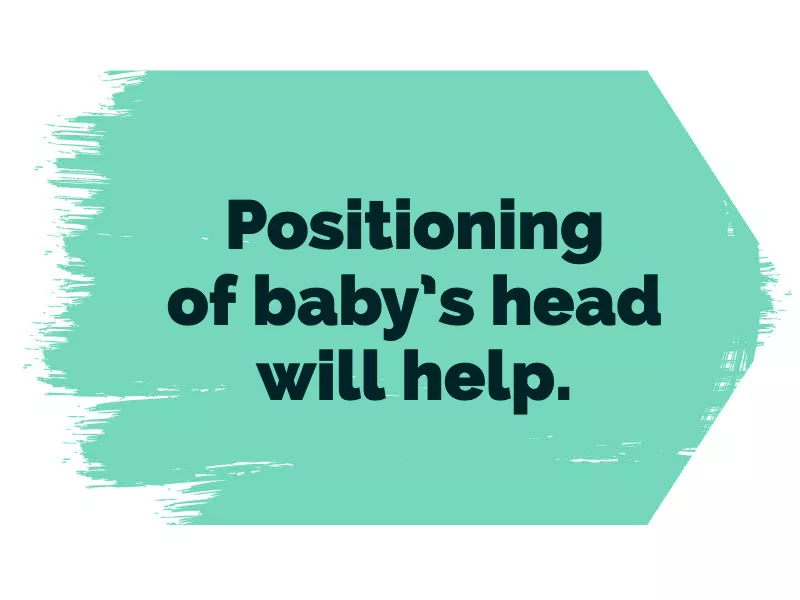
Treatment: None, things will even out in due time. and the soft spots will harden. But positioning of baby’s head will help. Holding baby while they’re awake and giving them time on their tummies will help relieve pressure spots.
When to contact the doctor: In rare cases, bony plates in baby’s head might fuse together prematurely. This can push other parts of the head out of shape as the brain grows. It must be treated in infancy, so talking to your pediatrician about head shape is good even if there’s nothing wrong with baby.